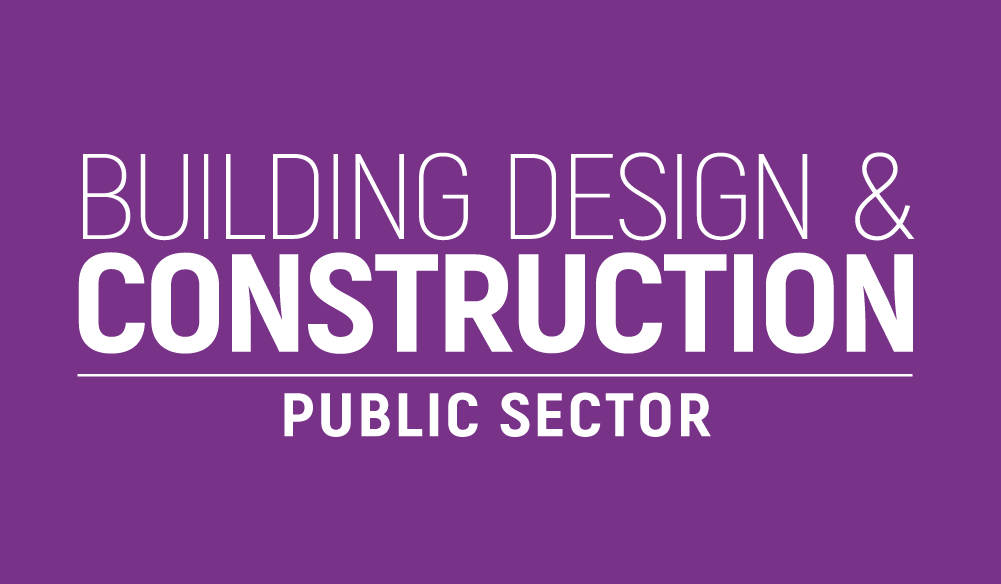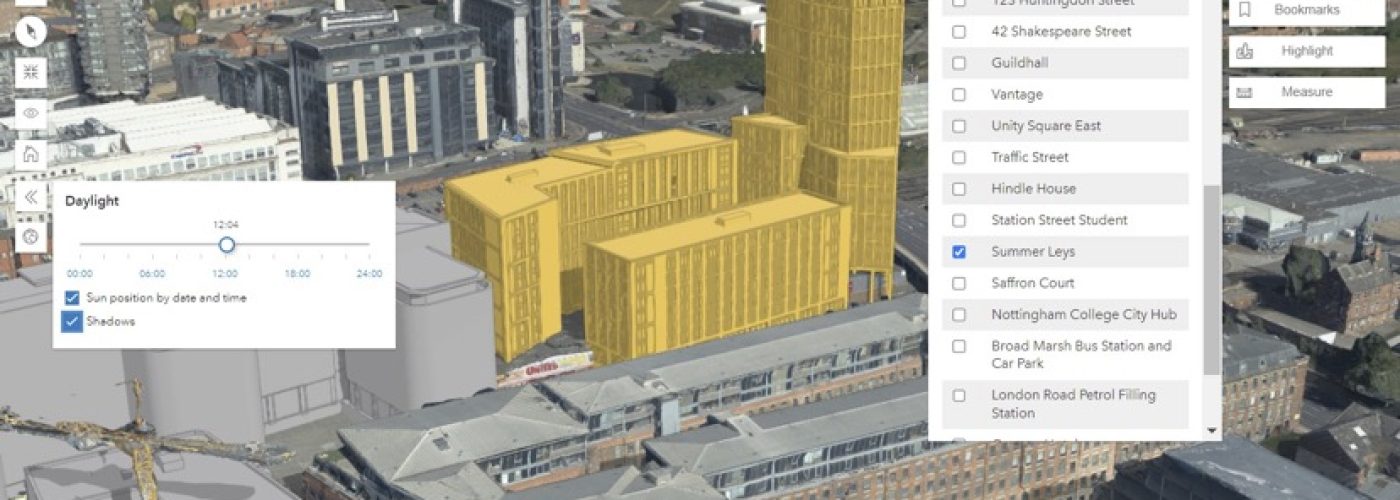Esri UK today announced the results of three pilot projects at Nottingham City Council, Dacorum Borough Council and South Ayrshire Council, which have been exploring new ways of digitising the planning process using geospatial technology. Projects have focused on solving common challenges within planning, including the improvement of community engagement, maximising the use of 3D visualisations and managing developer contributions more efficiently.
Having won a competition in Spring 2022 to find innovative ideas to improve planning, the councils have been working with Esri UK to make the projects a reality, receiving free consultancy and access to GIS (Geographic Information Systems) software.
Nottingham City Council’s pilot has proven the value of using 3D visualisations integrated with other existing data, to allow constraints and impact assessments to be carried out simultaneously. Dacorum Borough Council’s project has built a prototype tool which visualises infrastructure and developer contributions secured through Planning Obligations on a map, replacing traditional static spreadsheet data. While South Ayrshire Council’s outcome has been the creation of a community consultation platform, with interactive methods of engagement to improve community and other stakeholder involvement in Local Development Plans.
“The pilots have explored modern digital approaches to some common challenges faced by local planning authorities, all designed to help make the planning process more efficient and easier for everyone,” explained Stephen Croney, Head of Sector for Land, Property and Planning, Esri UK. “Combining each council’s domain expertise with our team of geospatial experts, the pilots have revealed how geospatial technology available today can help shape the future of the planning process by delivering significant cost and time savings.”
Results of the pilots in more detail:
Nottingham City Council

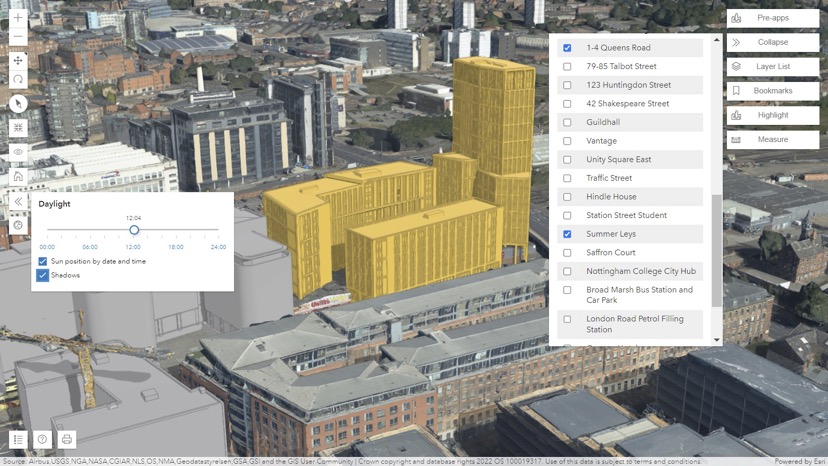
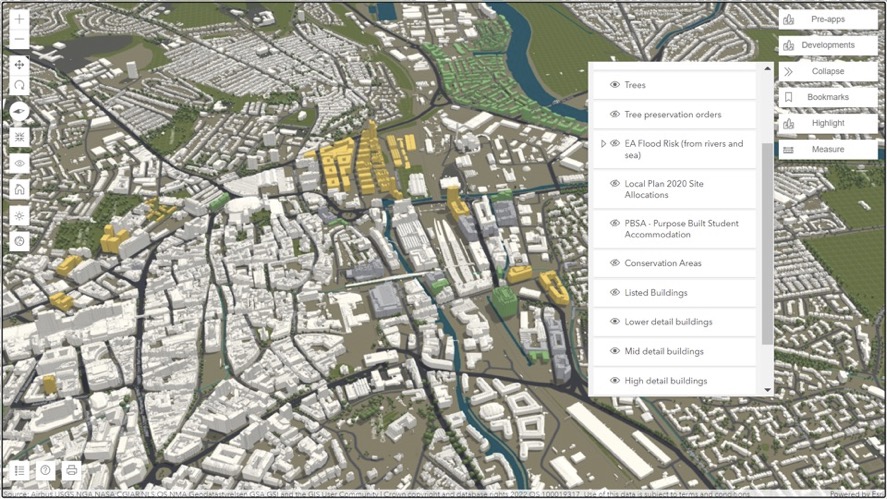
Nottingham City Council’s project has explored how geospatial technology can help increase the use of 3D visualisations, both internally and with the public. A prototype site assessment tool has been built that brings together all relevant spatial data into one 3D environment, including the proposed scheme itself, plus conservation areas, site allocations, flood risk and tree cover.
This has allowed planning teams to conduct 3D assessments of various constraints on a site, at the same time as a visual impact assessment, which speeds up the decision-making process. The project overcame the usual challenges of working with LOD3 (Level of Detail 3) performance in a browser to create a smooth user experience.
“The pilot has significantly advanced our 3D development skills, created new 3D data generation and manipulation techniques and shown how it’s possible to have a 3D environment which can easily integrate with our existing datasets,” explained Mick Dunn, GIS Service Manager, Nottingham City Council. “Overall, the project has proved that 3D planning is possible from any browser at the right performance levels.”
“The benefits are varied, from understanding what a building will look like in situ and trying different view corridors to assess its visual impact, to examining master planning issues, flood risk assessments or potential solar energy sites. The 3D visualisations can also be used to gain public feedback or other parties using images and fly-throughs.”
Next steps include advancing the prototype site assessment tool to make it fully operational and creating some 3D showcase demonstrators to engage with internal business areas. “The long-term goal is to provide a versatile 3D environment that we are able to easily deploy and operationalise to support the needs of our business and customers, improving operational performance and enhancing customer service delivery,” concluded Dunn.
Dacorum Borough Council

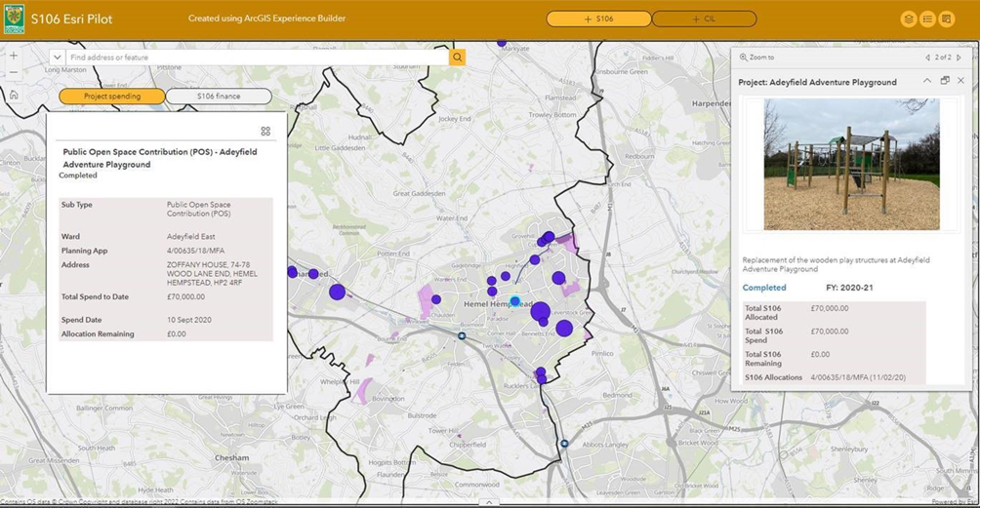
Dacorum Borough Council’s pilot has converted existing text and spreadsheet information into a modern digital mapping environment, improving how infrastructure and developer contributions secured through Planning Obligations are managed and communicated. An interactive map was built that plots the sources of developer contributions S106 and Community Infrastructure Levy (CIL) received and shows where the contributions have been spent.
“The pilot has shown the value of using digital maps to visualise and monitor contributions spatially and understand where and how the money is being spent,” commented Councillor Alan Anderson, Portfolio Holder, Planning and Infrastructure at Dacorum Borough Council. “The tool can give a clearer understanding of infrastructure funding received and how it links to infrastructure planned and delivered, by presenting the data visually and spatially, using an interactive web experience. Providing this information in a spatial way gives Council officers a powerful asset which can be used for planning, decision making and monitoring.”
Work is continuing on the tool to integrate regular, automated data feeds to make the application more streamlined and current. Once this work is completed the intention is to make the tool available online to allow the public to understand the process and engage in infrastructure funding and planning. Future plans might also include adding more layers of data, such as growth scenarios and strategic sites, to help with planning financial and non-financial developer contributions that will be needed to fund and deliver infrastructure required.
“One of the most obvious findings of the pilot has been how GIS can create interactive experiences with this financial data – particularly the ability to change dull, static spreadsheets into more meaningful, visual data that can be used for multiple purposes,” continued Councillor Anderson. “The value of partnership working has also been demonstrated – Dacorum providing the data and planning process knowledge and Esri UK providing the technical expertise.”
South Ayrshire Council
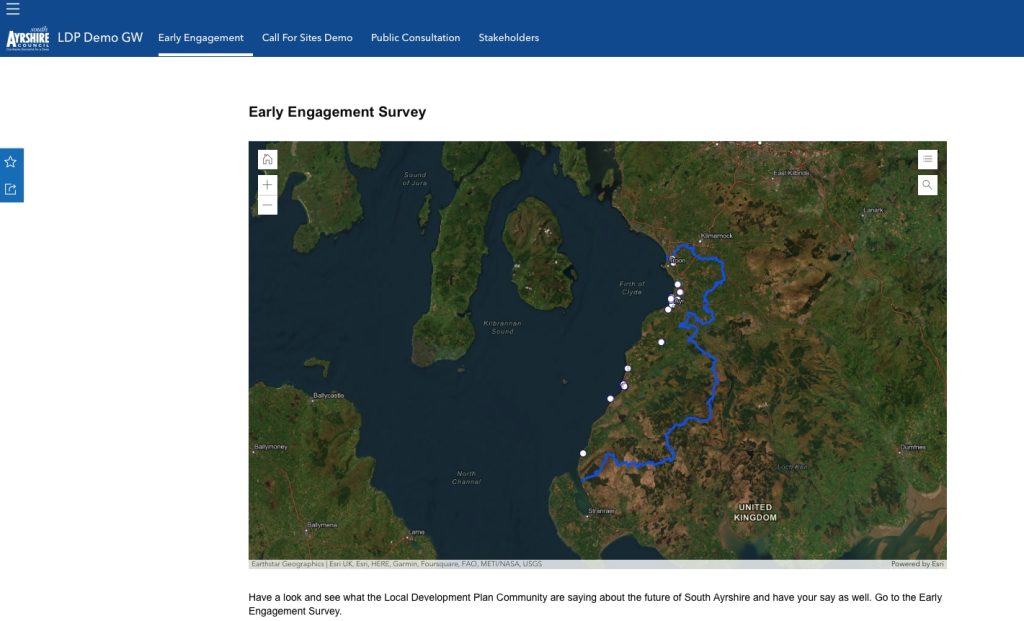

South Ayrshire Council’s pilot project examined how a consultation platform using interactive engagement methods can help improve community and stakeholder engagement in Local Development Plans, in order to reach better planning outcomes. The collaboration between the council and Esri UK has created a platform designed to keep the public and other parties engaged and informed, to strengthen the local planning authority’s relationship with its communities and reach better planning outcomes.
Built using Esri UK’s community engagement platform ArcGIS Hub, it keeps citizens informed via social media and asks their opinion on what they feel are the main planning issues within their community. The system plots these comments on an interactive map to highlight any issues and reveal policy engagement hotspots.
From an internal perspective, South Ayrshire’s planning officers now use a new Local Development Plan map dashboard, containing sites, stakeholder assessments and public comments, allowing them to assess the site and run a report on the selection process. Previously, this reporting was done manually and separately in Excel.
“Esri UK’s flexible suite of digital tools have helped to improve the LDP process and enhance our community and stakeholder engagement, raise our workload capacity, eliminate participation barriers and drive better outcomes,” said Gordon Wilson, Planning Technician at South Ayrshire Council. “The timing is important as this project to build a planning portal has coincided with the start of the LDP3 process. It’s expected that the hub will start to show how the LDP will plan out and highlight key milestones during the LDP process.”
“The platform will enhance South Ayrshire’s commitment to encouraging participation from as wide a range of stakeholders as possible in all LDP related activities, such as masterplans, development briefs and other guidance published throughout the lifetime of the plan. The more people who become involved will improve confidence in the fairness of the planning system.”
All three local authorities will be discussing their projects in a free webinar on Wednesday 15 March 2023 at 10:00-11:00am.
Building, Design & Construction Magazine | The Choice of Industry Professionals
